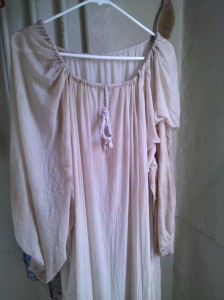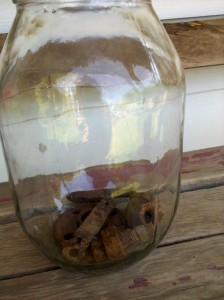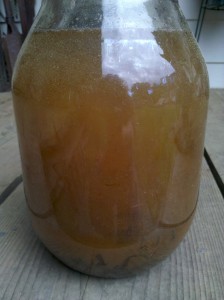Sustainable Tea Dyeing
Actually, there really IS no such thing if you live here in Northern California… at least not until my two Camellia sinensis plants reach maturity, I learn to properly cure their leaves, and then use them to dye with. More likely, I would be saving them to drink! I do love my spiced black tea!
I have to admit that I have been in love with tea-dyeing for several decades. It was not my first foray into natural plant dyes, but it certainly has been a fast and satisfying one over the years. Just grab a bunch of tea bags, brew a big pot (and you can safely use a kitchen pot), and throw something in. It has served me well in ‘antiquing’ fabrics for a specific use, such as historical re-enactment, has quickly covered up stained or mildewed fabrics giving them a nice, new life, and I like the soft, muted color – kind of pinky-beige. So, when I was out shopping at my local Grocery Outlet, and came across boxes of 25 organic black tea bags for $1.49, how could I resist?
I was forced inside from my gardening efforts yet again this morning, because of heavy rain showers, and thought I would pull out my dye kettle and work on an inside project… many of the projects waiting in the queue, such as alum and rhubarb mordanting, will involve the outdoors so that the fumes don’t overpower us, but tea provides a pleasing and safe aroma on a dreary day.
As the water was heating and I was unwrapping all 25 tea bags (50 grams of tea total), I got to musing about the unsustainability of the whole thing and how I would have to find a replacement. First, here I was unwrapping each separately packaged bag… while nice and tidy in not getting tea leaves all over the place, there was all that paper, the strings, the staples… I recalled that Celestial Seasonings has been using simple bags for decades that aren’t individually wrapped and don’t have either string or staple. Nice of them! I can burn all of the paper wrappings, tags and the box in my woodstove, and can empty the tea leaves out when done, drying and burning the paper bags and composting the tea, but still… life with less packaging is the better way.
Worse than that, all 50 grams of tea in that box most likely traveled on a container ship across the ocean from Sri Lanka, its country of origin according to the box. Obviously, not a sustainable way to go. So, what can I replace this with?
Probably the simplest ‘fast and easy’ replacement would be to shift to iron-object mordanting. I have lots of rusty objects right here on my property (along with lots of broken glass, as the pasture behind the barn was used as the household dump for about a century). I recently gathered up some of them and put them in a gallon jar with a cup of vinegar (not locally produced, but it is possible to divert some of the apple crop in the region to vinegar production) and topped it off with water.
After several days of soaking, there is a distinctly rusty-brown appearance which would dye cotton or wool with a pale beige to orange-y color, depending upon how long you soaked the textile in the solution, and how strong you made it. This might not be every bit as fast as tea dyeing, but could certainly serve as a sustainable replacement. I finished up dyeing the chemise and a white blouse from one of my Gold Rush-era costumes, threw the tea bags back in to extract as much dye as possible, and will save the dye bath for another round soon, but will also be steeping some pieces in the iron mordant jar for comparison!














Thank you for posting your experience! I am especially fond of your concern for locally produced and sustainable sources. I have been experimenting with natural dying process for many years as well. I only dabble, but playing teaches many things. My favorite dye is a bath of Madrone bark I have been boiling for two years off and on. It is strong and syruppy and leaves a nice ‘naked’ hue on white, natural fiber fabrics. As a fixative I use white vinegar. I am curious if you have found any fixatives among the plant world which might be more local and sustainable?
Thanks
T